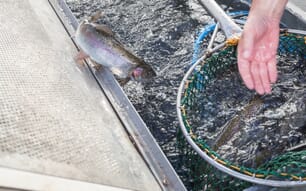Rainbow Trout - By Katheleen F. Ladewig and Michelle Morat and published by the Southern Regional Agricultural Center and the Texas Aquaculture Extension Service - The rainbow trout has always been known as a great sport fish. But, in recent times, along with its sport connotation, it has also gained recognition as a tasty, nutritious dinner for all diets. 
Traditionally, the typical American diet is high in calories, total fat, saturated fat, cholesterol, salt, and sugar. However, in the last few years there has been a national interest in nutrition, physical fitness, and overall health. Americans are gradually changing their eating
habits and lifestyles as they become more aware of the role of diet in promoting good health and preventing disease. Dietitians and other health professionals now suggest that we consume less than 30 percent of calories from fat.
Fish can make a significant contribution toward reducing fat in our diet. Not only is fish low in fat, but it is also a tasty, highly nutritious and wholesome food that can offer an endless variety to menus. It can be a delightful addition to any meal, and is an excellent source of protein and other nutrients. Fish may often cost less per pound than some other meats because it has less inedible portions, like bones and fat. It is also easy to prepare and cooks in minutes rather than hours. With todays health conscious public searching for the right elements for a healthy diet, it is easy to see why fish is increasing in demand especially rainbow trout.
Characteristics
Rainbow trout are native from northern Mexico to southern Alaska west of the Rockies. Rainbow trout prefer clear, cool, high quality water. Sometimes trout migrate to the ocean where they spend several years of their life. Rainbow trout have long been known for the spectacular leaps
and runs they make when caught by the sport fisherman in swift, cool, white-water rivers. These fish always put up a good fight during the catch. Rainbow trout are easily identified by the broad reddish band or rainbow which runs along their side from head to tail.
The reddish band blends into a dark olive green on the back and pure white or silver on the belly. The back, dorsal fin and tail are generously sprinkled with black spots. The brightness of color varies with where the rainbow trout lives and what it eats.
Commercial trout
Consumers no longer have to try their luck at fishing in order to enjoy rainbow trout. Because of new research, scientists have developed environmental raceways and improved feeding conditions to encourage the production of fast-growing, healthy trout. Improved production practices, selective breeding and nutritionally complete feeds now make it possible to produce market size (10- to 14-ounce) trout in as little as 10 months. Today, with modern rearing and shipping techniques about 95 percent of rainbow trout consumed in the United States is farm raised and available nationwide any time of the year at very reasonable prices.
Market forms
Rainbow trout are generally sold fresh in many seafood markets and packed in ice. Because of their smaller size trout are usually sold whole and either dressed or butterfly style.
Nutritional value
The Food Guide Pyramid is designed to show consumers the types and amounts of foods that they should eat each day for optimal nutrition. According to the Food Guide Pyramid, each person should consume at least 2 servings a day from the meat, poultry, fish, and dry bean group, while still trying to consume fewer high-fat foods.
Rainbow trout is an excellent meat group choice because it is lower in fat and calories than some foods from the meat group and is also a good source of many important nutrients. A 3-ounce serving of cooked rainbow trout contains 22 grams of protein and only 130 calories, 4 grams of fat, 1 gram of saturated fat, and 30 milligrams of sodium.
Health conscious Americans should consider including rainbow trout in their diet. Whether you prepare and eat trout at home or at a restaurant, rainbow trout is a delicious, nutritious, and healthy choice.
Cost
Another advantage of trout in addition to its nutritional value is its lower price per pound of edible meat.
For example:
Cost per serving of different foods from the meat group:
1 1/2 cups cooked kidney beans = $0.66
3 ounces cooked trout = $1.02
3 ounces cooked chicken = $1.19
3 ounces cooked pork = $1.53
3 ounces cooked beef = $1.92
But remember, the more processed the fish, the higher the cost.
For example:
Dressed trout (cleaned, with head and tail still on) = $3.49 per pound.
Butterfly (cleaned, with head and tail removed) = $3.79 per pound.
Food safety
During purchasing:
When purchasing rainbow trout, or any fish, check for freshness. Fresh whole trout have:
- clear and bulging eyes
- light pink or white firm flesh
- shiny skin
- no brown or yellow on edges
- fresh, ammonia-free odor
- red, moist gills
If you will not be cooking the trout within a 24-hour period:
- place on a cake rack in pan
- fill the pan with ice
- cover with foil or plastic wrap
- place in refrigerator at 32 to 37°F
If you will not be cooking the
trout within 2 days:
- wrap tightly and freeze immediately at 0°F or lower to help prevent freezer burn (only foods not previously thawed from frozen; never refreeze foods)
- commercially frozen trout will keep fresh for 7 to 9 months.
Preparation
Thawing:
- Thaw fish in refrigerator when ready to prepare, allowing 24 hours for a 1-pound package
- Never thaw fish at room temperature
- Unfrozen or thawed fish will keep fresh no longer than 36 hours.
Pre-preparation:
When you buy the fish fresh from your supermarket for dinner the same night:
- wash hands thoroughly
- keep equipment clean
- store fish in refrigerator
- prepare the trout in as little time as possible
- remove from package
- rinse with cold water
- pat dry with paper towel
- start preparation.
Cooking
Always cook fish before eating it. When you decide to create a wonderful meal with your rainbow trout, here are a few cooking tips to make your sensational creations a cinch!
First of all, leave scales on the fish. The jelly around the scales permits the trout to be breaded or coated without using any type of liquid. This allows for easy, all-natural cooking.
Next, leave the head or tail on while cooking. This minimizes skin breakage, and foreign flavors. If broiling, place the trout 4 inches
or more away from the heat.
Turning the fish is not necessary during broiling. It will baste in its own juices, making it tender and well-done.
If you are baking, cook the trout at 400 to 425°F for the period of time the recipe calls for. Test by probing a fork into the fish to see if it is done. Do not turn. If the fish is ready, it will come easily off the fork as you pull it out of the fish.
10-Minute rule
The 10-minute rule is one way to cook fish by conventional method (but not deep-frying or microwaving). It can be used for baking at 400 to 450oF, grilling, broiling, poaching, and steaming. Here is how to use the 10-minute rule: Measure the fish at its thickest point. If the fish is stuffed or rolled, measure after stuffing or rolling.
Cook fish about 10 minutes per inch, turning it halfway through the cooking time. For example, a 1-inch fish steak should be cooked for 5 minutes on each side for a total of 10 minutes. Pieces less than 1/2 inch thick do not have to be turned over. Test for doneness. Flake with a fork. Fish should reach an internal temperature of 145°F. Add 5 minutes to the total cooking time for fish cooked in foil or in a sauce.
Double the cooking time for frozen fish that has not been defrosted. Use this rule as a general guideline since fillets often do not have uniform thickness.
In the microwave
To cook fresh trout in the microwave, make three slashes across the entire body of the fish on both sides. Brush the cavity and both sides generously with margarine. Sprinkle the cavity with lite salt and seasonings to taste. Cook for 5 minutes on high. Turn the trout and microwave for 5 more minutes. Remove from the microwave and let stand, covered, for 3 minutes. Meat should flake easily, and not be soft to the touch. The dorsal fin should be easy to remove.
Simple ideas to spice up your entrees
One way to make a great trout meal is by stuffing filets. Here are some delicious suggestions: For orange rice stuffing, cook 2 to 3 cups of rice in 4 parts water, 2 parts orange juice and 1 part lemon juice. Add sauteed chopped celery, onions, slivered almonds and fresh chopped parsley. Stuff trout with rice mixture. Brush with orange juice, lite oil, and bake until golden brown. For succotash stuffing, season
cooked, diced carrots, corn, lima beans, and green peppers with lemon pepper. Stuff trout with vegetables, drizzle cavity with margarine and bake until golden brown.
For wild rice stuffing, cook long grain and wild rice in beef or seafood stock with your choice of herbs. Add sauteed mushrooms and chopped parsley to the stuffing. Stuff trout and bake until golden brown.
Trout toppings
Some other simple ways to dress up trout are with breading or sauces. The recipe for French Bread Fish coats trout and still keeps the dish low-fat by baking instead of frying. Just dip trout in skim milk and low-fat egg mix or egg whites,wash and coat in coarse French
bread crumbs seasoned with lite salt and paprika and bake according to the 10-minute rule.
Mushroom Sauce, Sauce Marinara, and Herb Sauce are all excellent complements to trout entrees. For the mushroom sauce, saute sliced mushrooms in margarine and flour. Add 4 parts chicken bouillon, 1 part tomato sauce, and season with parsley, dill, and poultry seasoning. Simmer half
an hour and serve piping hot over broiled trout. For sauce marinara, simmer canned tomatoes, garlic, parsley, oregano, salt and pepper in
lite vegetable oil for 20 to 30 minutes. Serve hot over broiled or baked trout. For herb sauce, saute chopped scallions in margarine with thyme, oregano, sage, rosemary and marjoram. Season to taste. Serve hot over trout.
Great garnishes and sensational seasonings
To simply dress-up your entree, consider using some of these suggestions:
- carrot curls
- green pepper rings
- lemon crowns or wedges
- radish roses
- parsley
- chopped watercress
- sliced toasted almonds
- chopped chives
- scallions
- paprika
With any of these garnishes, be as creative as you like, remembering taste, but that little extras can make the meal!
There are many reasons for the increased popularity of rainbow trout. It is a great sport fish. It fits into a healthy lifestyle. You can now purchase it in supermarkets any time of year and at very reasonable prices. It is simple and quick to prepare. But no matter why you decide to try rainbow trout, youll find it a delicious choice that will keep you and your family coming back for more.
Further Information
For more information on Trout Production, see the links below:
- Trout Production: Handling Eggs and Fry
- Budgets for Trout Production: Estimated Costs and Returns for Trout
- Trout Farming: Carrying Capacity and Inventory Management
- Trout Production: Feeds and Feeding Methods
Source: Southern Regional Agricultural Center and the Texas Aquaculture Extension Service - Taken from site - April 2006


